Analysis of Foundation Pit Excavation Deformation and Parameter Influence of Pile-Anchor-Ribbed-Beam Support System
Abstract
1. Introduction
2. Project Profile
2.1. Engineering Background
2.2. Original Composite Support Structure of Pile-Anchor-Beam (PAB)
2.3. New Composite Support Structure of Pile-Anchor-Ribbed-Beam (PARB)
3. Numerical Simulation Model
3.1. Calculation Assumptions
3.2. Model Size and Boundary Conditions
3.3. Material Constitutions and Parameters
3.4. Calculation Process
4. Analysis of Calculation Results
4.1. Surface Settlement
4.2. Lateral Deformation of Retaining Structure
4.3. Analysis of Pile Top Settlement
5. Analysis of Parameters Influence
5.1. Pile Embedded Depth
5.2. Ribbed Beam Size
5.3. Waist Beam Size
6. Conclusions
Author Contributions
Funding
Acknowledgments
Conflicts of Interest
References
- Zhao, X.; Wang, H.; Li, Z.; Dai, G.; Yin, Z.; Cao, S.; Zhou, J. Numerical Study on the Deformation of Tunnels by Excavation of Foundation Pit Adjacent to the Subway. Appl. Sci. 2022, 12, 4752. [Google Scholar] [CrossRef]
- Zhang, J.; Qiao, G.; Feng, T.; Zhao, Y.; Zhang, C. Dynamic back analysis of soil deformation during the construction of deep cantilever foundation pits. Sci. Rep. 2022, 12, 1–16. [Google Scholar] [CrossRef]
- Yuan, J.; Lin, P.; Mei, G.; Hu, Y. Statistical prediction of deformations of soil nail walls. Comput. Geotech. 2019, 115, 103168. [Google Scholar] [CrossRef]
- Johari, A.; Hajivand, A.; Binesh, S. System reliability analysis of soil nail wall using random finite element method. Bull. Eng. Geol. Environ. 2020, 79, 2777–2798. [Google Scholar] [CrossRef]
- Danziger, F.; Danziger, B.; Pacheco, M. The simultaneous use of piles and prestressed anchors in foundation design. Eng. Geol. 2006, 87, 163–177. [Google Scholar] [CrossRef]
- Zhang, Q.; Hu, J.; Wang, J.; He, P.; Hou, L.; Lin, P.; Song, S. Study on the mechanical behavior of a foundation pit retaining structure adjacent to the pile foundation of a subway station. Environ. Earth Sci. 2021, 80, 1–10. [Google Scholar] [CrossRef]
- Zheng, C.; Franza, A.; Jimenez, R. Analysis of floating and end-bearing pile foundations affected by deep-excavations. Comput. Geotech. 2023, 153, 105075. [Google Scholar] [CrossRef]
- Liu, W.; Li, T.; Wan, J. Deformation Characteristic of a Supported Deep Excavation System: A Case Study in Red Sandstone Stratum. Appl. Sci. 2021, 12, 129. [Google Scholar] [CrossRef]
- Cui, G.; Ma, S.; Liu, Z.; Liu, S.; Xi, C.; Cheng, Z. Effect of freeze–thaw cycles on deformation properties of deep foundation pit supported by pile-anchor in Harbin. Rev. Adv. Mater. Sci. 2022, 61, 756–768. [Google Scholar] [CrossRef]
- Su, T.; Zhou, Y.; Wang, Z.; Ye, S. Large Scale Model Test Study of Foundation Pit Supported by Pile Anchors. Appl. Sci. 2022, 12, 9792. [Google Scholar] [CrossRef]
- Liu, Y.; Wang, C.; Liu, X.; Gao, R.; Li, B.; Khan, K.U.J. Determination of embedded depth of soldier piles in pile-anchor supporting system in granite residual soil area. Geofluids 2021, 2021, 5518233. [Google Scholar] [CrossRef]
- Maleki, J.; Pak, A.; Yousefi, M.; Aghakhani, N. A comprehensive FE study for design of anchored wall systems for deep excavations. Tunn. Undergr. Space Technol. 2022, 122, 104340. [Google Scholar] [CrossRef]
- Zhao, W.; Han, J.-Y.; Chen, Y.; Jia, P.-J.; Li, S.-G.; Li, Y.; Zhao, Z. A numerical study on the influence of anchorage failure for a deep excavation retained by anchored pile walls. Adv. Mech. Eng. 2018, 10, 1687814018756775. [Google Scholar] [CrossRef]
- Zhang, D.-M.; Xie, X.-C.; Li, Z.-L.; Zhang, J. Simplified analysis method for predicting the influence of deep excavation on existing tunnels. Comput. Geotech. 2020, 121, 103477. [Google Scholar] [CrossRef]
- Mitew-Czajewska, M. A study of displacements of structures in the vicinity of deep excavation. Arch. Civ. Mech. Eng. 2019, 19, 547–556. [Google Scholar] [CrossRef]
- Jiang, L.; Hao, S. Resilience Evaluation of the Existing Shield Tunnel Lining Induced by the Symmetrical Excavation of Adjacent Foundation Pit Based on Numerical Simulations. Symmetry 2022, 14, 229. [Google Scholar] [CrossRef]
- Lei, G.; Guo, P.; Hua, F.; Gong, X.; Luo, L. Observed performance and FEM-based parametric analysis of a top-down deep excavation in soil-rock composite stratum. Geofluids 2021, 2021, 6964940. [Google Scholar] [CrossRef]
- Deng, H.; Fu, H.; Shi, Y.; Huang, Z.; Huang, Q. Analysis of Asymmetrical Deformation of Surface and Oblique Pipeline Caused by Shield Tunneling along Curved Section. Symmetry 2021, 13, 2396. [Google Scholar] [CrossRef]
- Deng, H.-S.; Fu, H.-L.; Yue, S.; Huang, Z.; Zhao, Y.-Y. Ground loss model for analyzing shield tunneling-induced surface settlement along curve sections. Tunn. Undergr. Space Technol. 2022, 119, 104250. [Google Scholar] [CrossRef]
- Ahmed, B.; Voyiadjis, G.; Park, T. Damaged plasticity model for concrete using scalar damage variables with a novel stress decomposition. Int. J. Solids Struct. 2020, 191, 56–75. [Google Scholar] [CrossRef]
- Park, T.; Ahmed, B.; Voyiadjis, G. A review of continuum damage and plasticity in concrete: Part I—Theoretical framework. Int. J. Damage Mech. 2022, 31, 901–954. [Google Scholar] [CrossRef]
- Gomathi, K.A.; Rajagopal, A.; Reddy, K.; Ramakrishna, B. Plasticity based material model for concrete subjected to dynamic loadings. Int. J. Impact Eng. 2020, 142, 103581. [Google Scholar] [CrossRef]
- Yang, Y.; Li, J.; Liu, C.; Ma, J.; Zheng, S.; Chen, W. Influence of deep excavation on adjacent bridge piles considering underlying karst cavern: A case history and numerical investigation. Acta Geotech. 2022, 17, 545–562. [Google Scholar] [CrossRef]
- Zhang, D.; Zhang, X.; Tang, H.; Zhao, Z.; Guo, J.; Zhao, H. Effects of soil arching on behavior of composite pile supporting foundation pit. Comput. Part. Mech. 2022, 1–18. [Google Scholar] [CrossRef]
- Shakeel, M.; Ng, C. Settlement and load transfer mechanism of a pile group adjacent to a deep excavation in soft clay. Comput. Geotech. 2018, 96, 55–72. [Google Scholar] [CrossRef]
- Rashidi, F.; Shahir, H. Numerical investigation of anchored soldier pile wall performance in the presence of surcharge. Int. J. Geotech. Eng. 2019, 13, 162–171. [Google Scholar] [CrossRef]
- Ramadan, M.I.; Meguid, M. Behavior of cantilever secant pile wall supporting excavation in sandy soil considering pile-pile interaction. Arab. J. Geosci. 2020, 13, 466. [Google Scholar] [CrossRef]
- Baziar, M.; Ghadamgahi, A.; Brennan, A. Numerical analysis of collapse in a deep excavation supported by ground anchors. Proc. Inst. Civ. Eng. Geotech. Eng. 2021, 174, 263–278. [Google Scholar] [CrossRef]
- Malhotra, H.; Singh, S. Effect of load inclination on the uplift capacity of the granular anchor pile foundation in cohesive soil. Arab. J. Geosci. 2022, 15, 1088. [Google Scholar] [CrossRef]
- Fall, M.; Gao, Z.; Ndiaye, B. Three-dimensional response of double anchored sheet pile walls subjected to excavation and construction sequence. Heliyon 2019, 5, e01348. [Google Scholar] [CrossRef]
- Ramadan, M.I.; Ramadan, E.H.; Khashila, M.M. Cantilever contiguous pile wall for supporting excavation in clay. Geotech. Geol. Eng. 2018, 36, 1545–1558. [Google Scholar] [CrossRef]
- Do, T.-N.; Ou, C.-Y.; Chen, R.-P. A study of failure mechanisms of deep excavations in soft clay using the finite element method. Comput. Geotech. 2016, 73, 153–163. [Google Scholar] [CrossRef]
- Nejjar, K.; Dias, D.; Cuira, F.; Chapron, G.; Lebissonnais, H. Experimental study of the performance of a 32 m deep excavation in the suburbs of Paris. Géotechnique 2021, 1–11. [Google Scholar] [CrossRef]
- Nicotera, M.; Russo, G. Monitoring a deep excavation in pyroclastic soil and soft rock. Tunn. Undergr. Space Technol. 2021, 117, 104–130. [Google Scholar] [CrossRef]
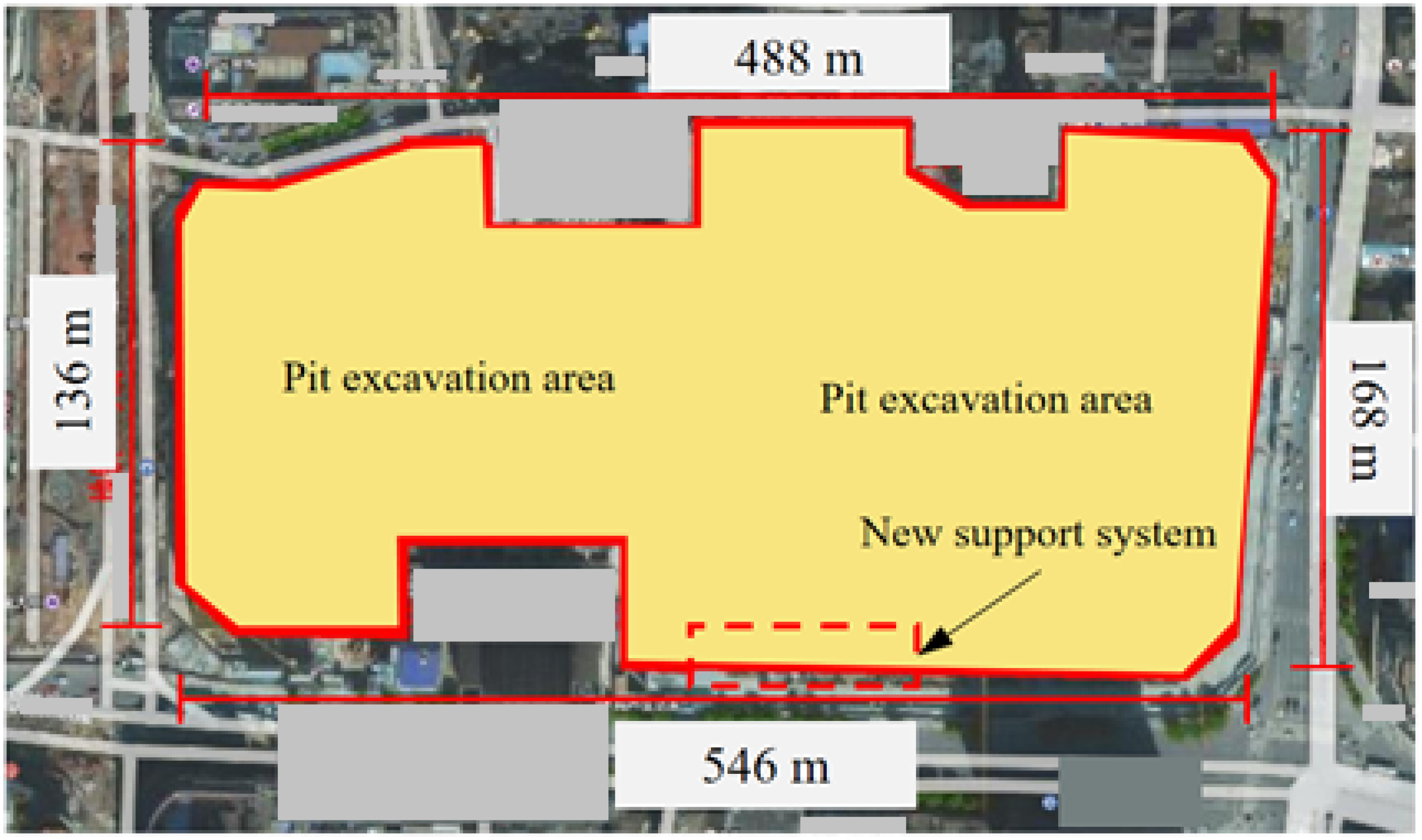
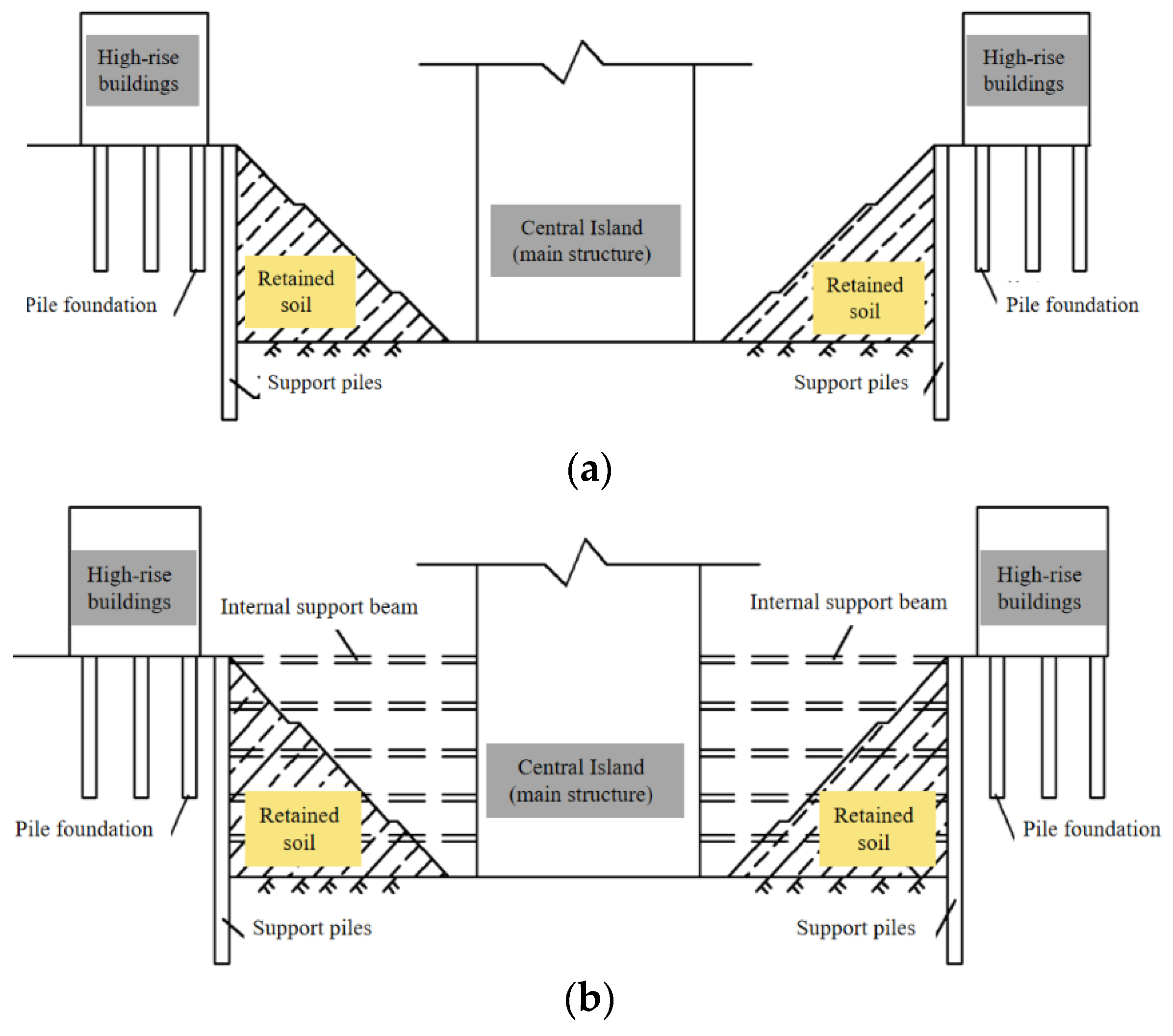

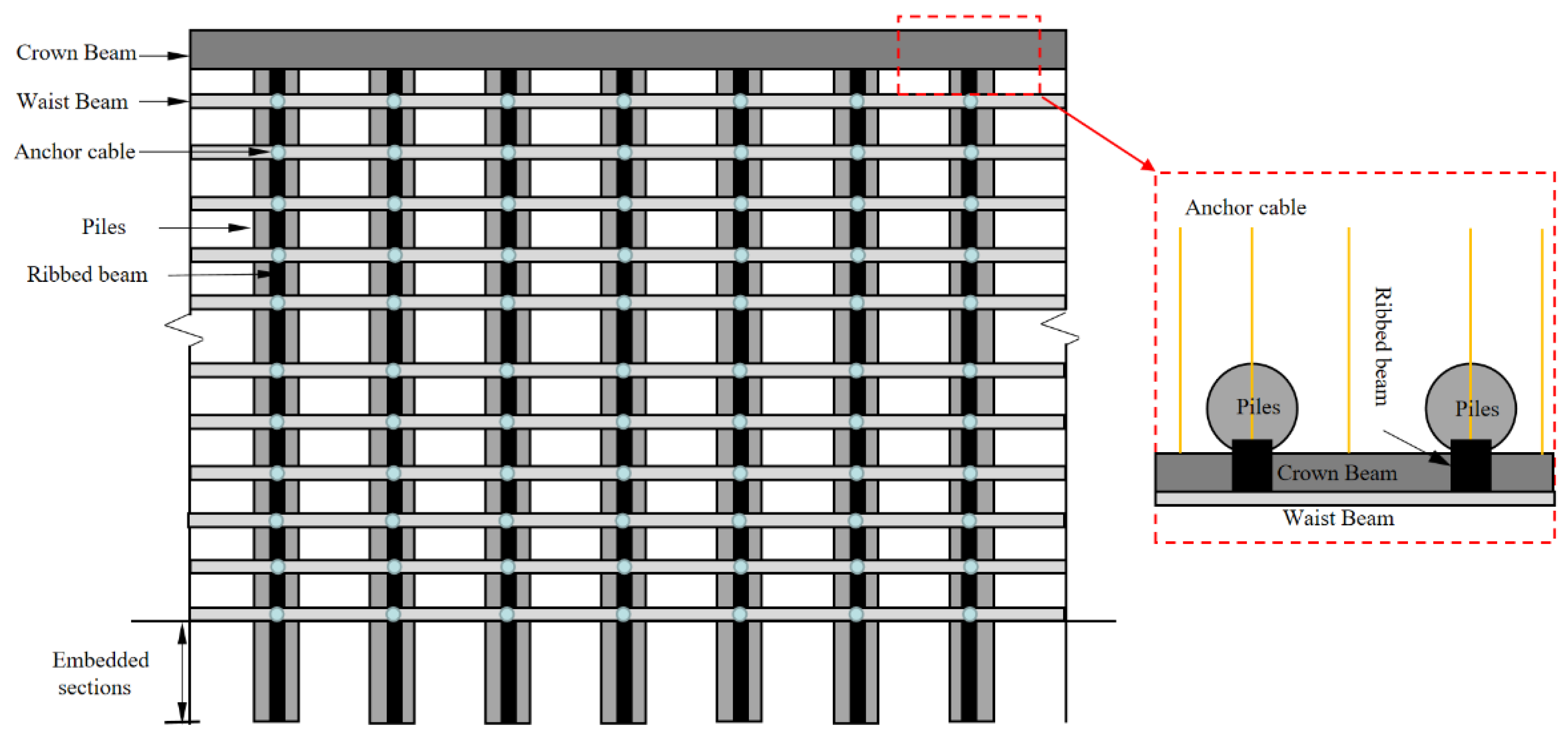


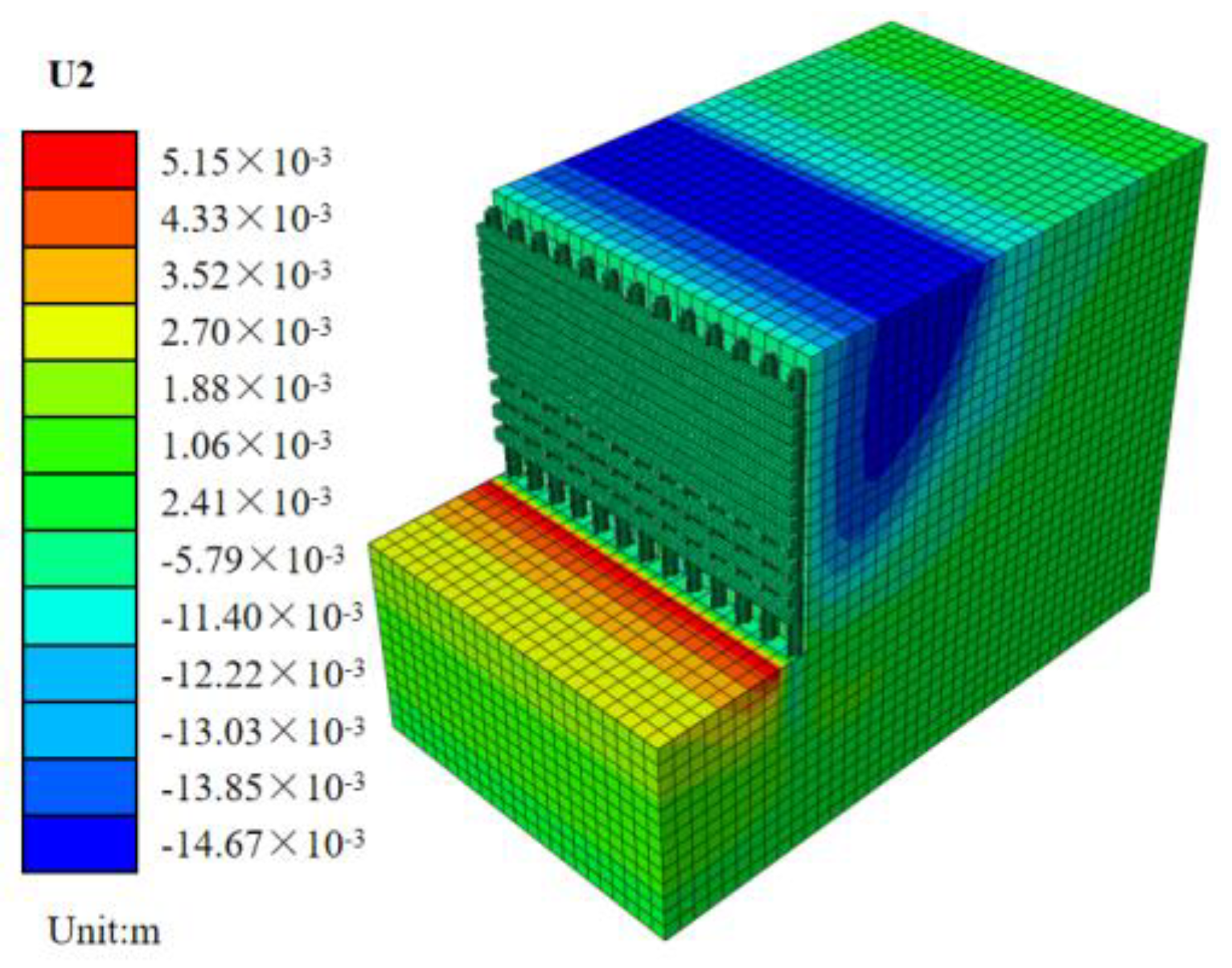
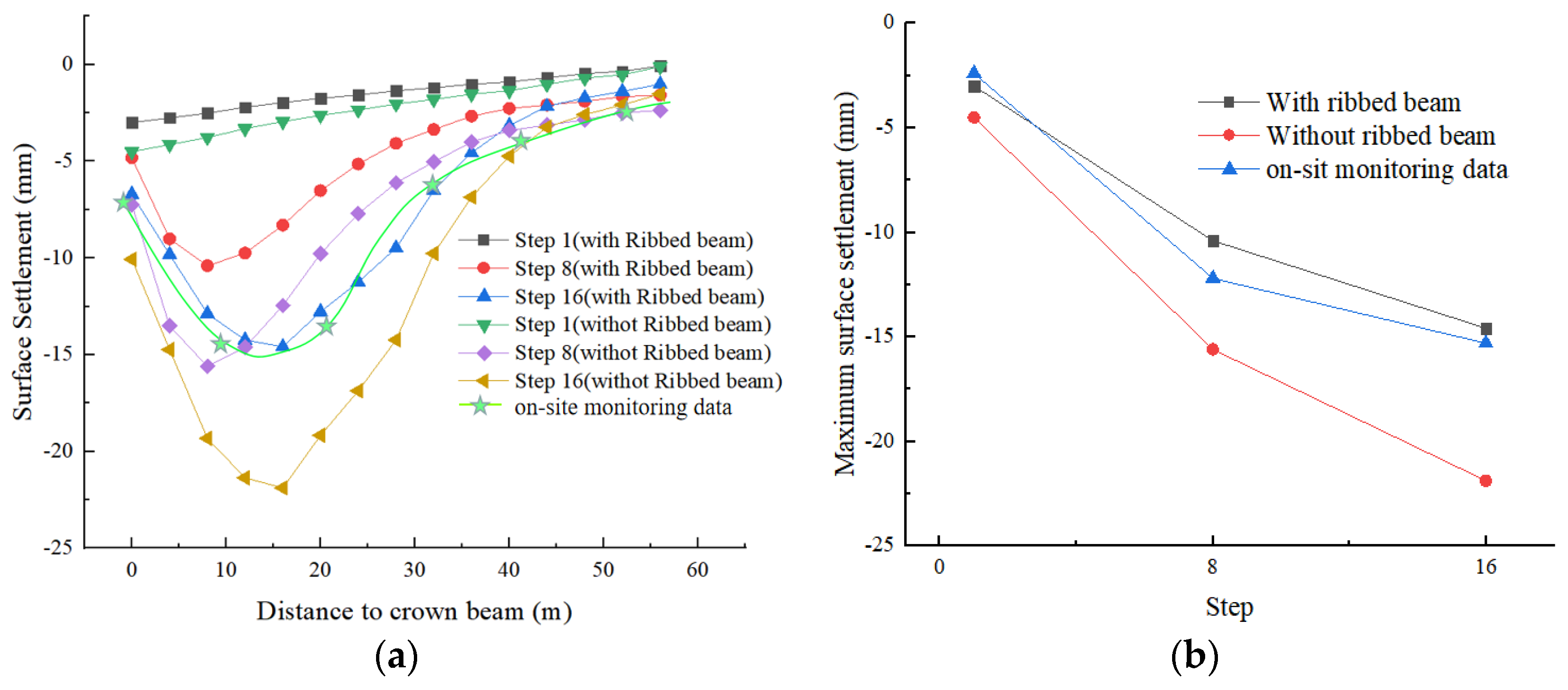
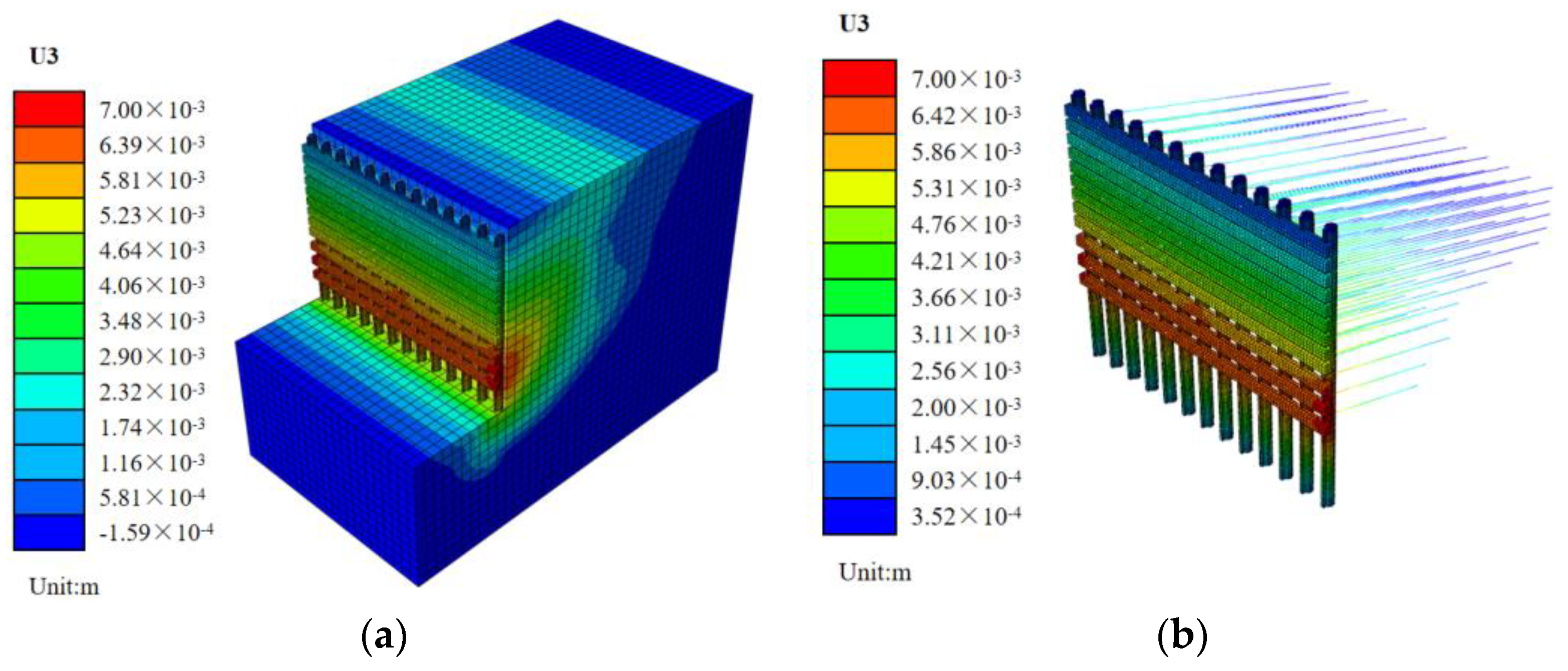


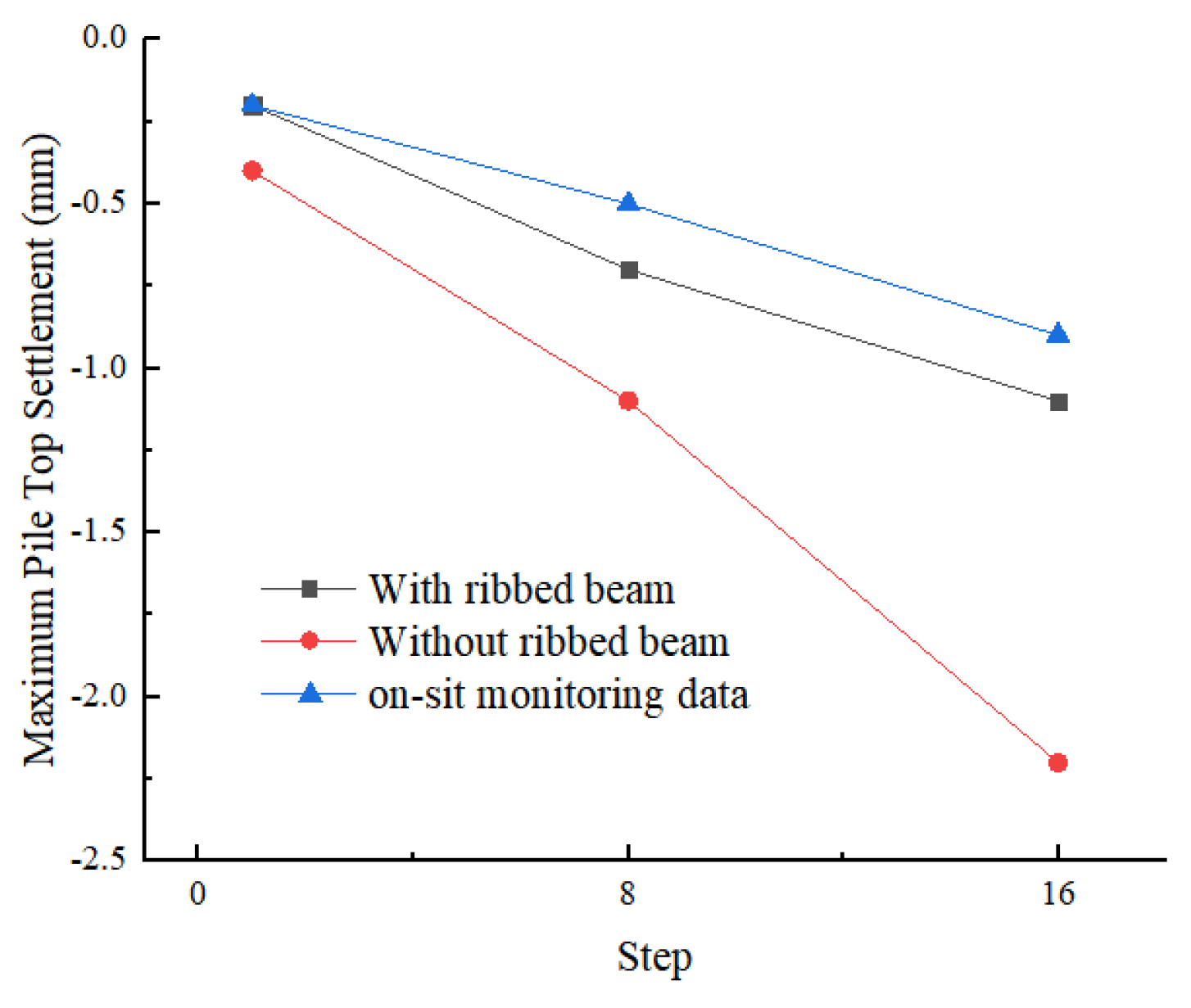
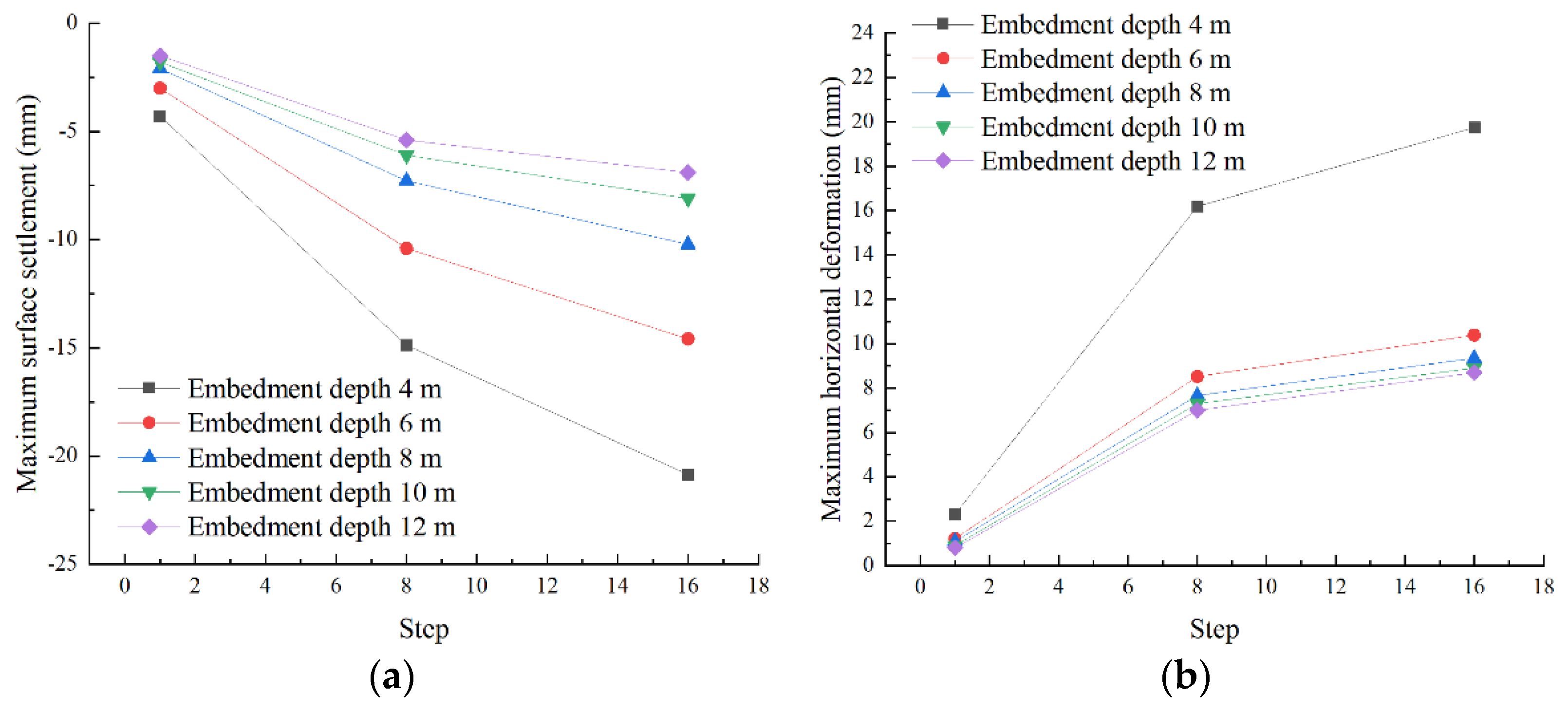
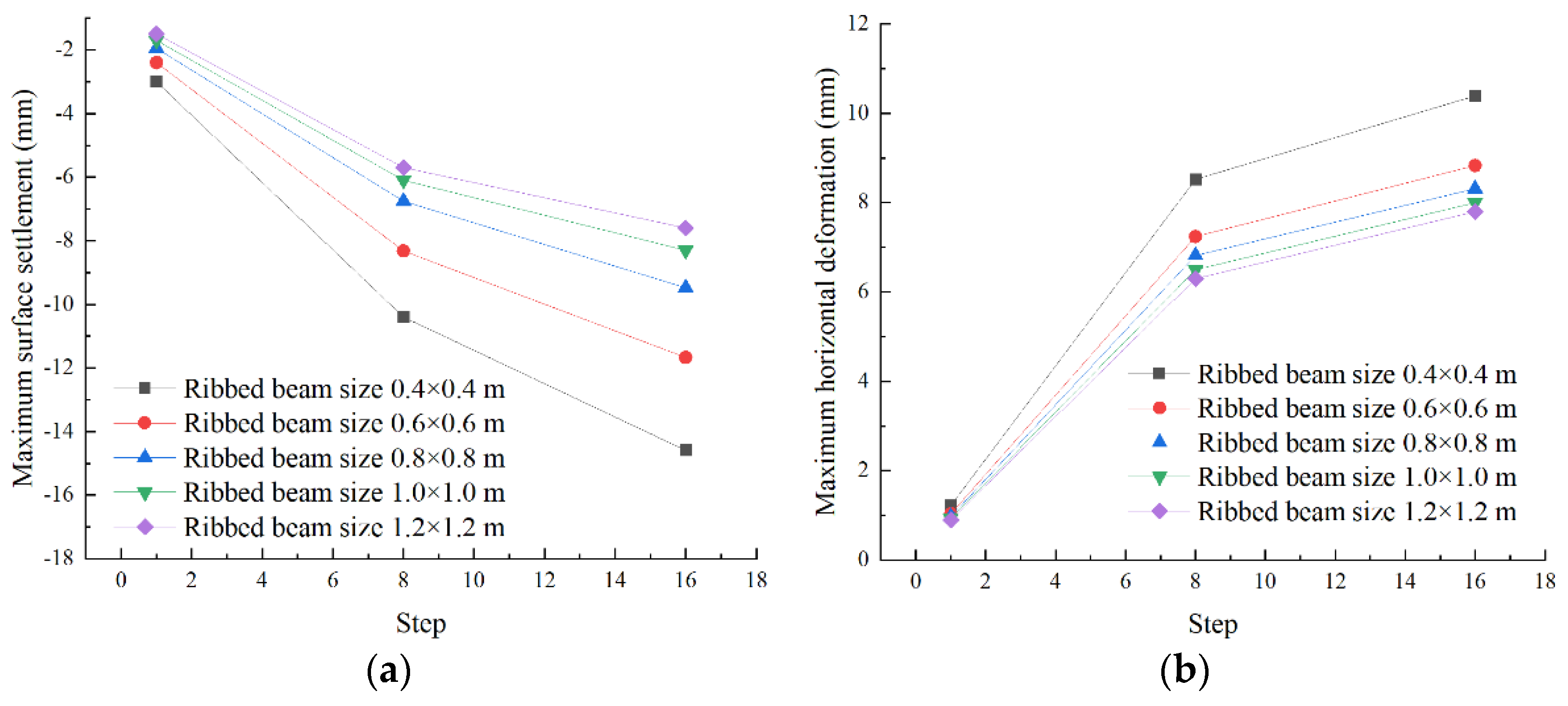
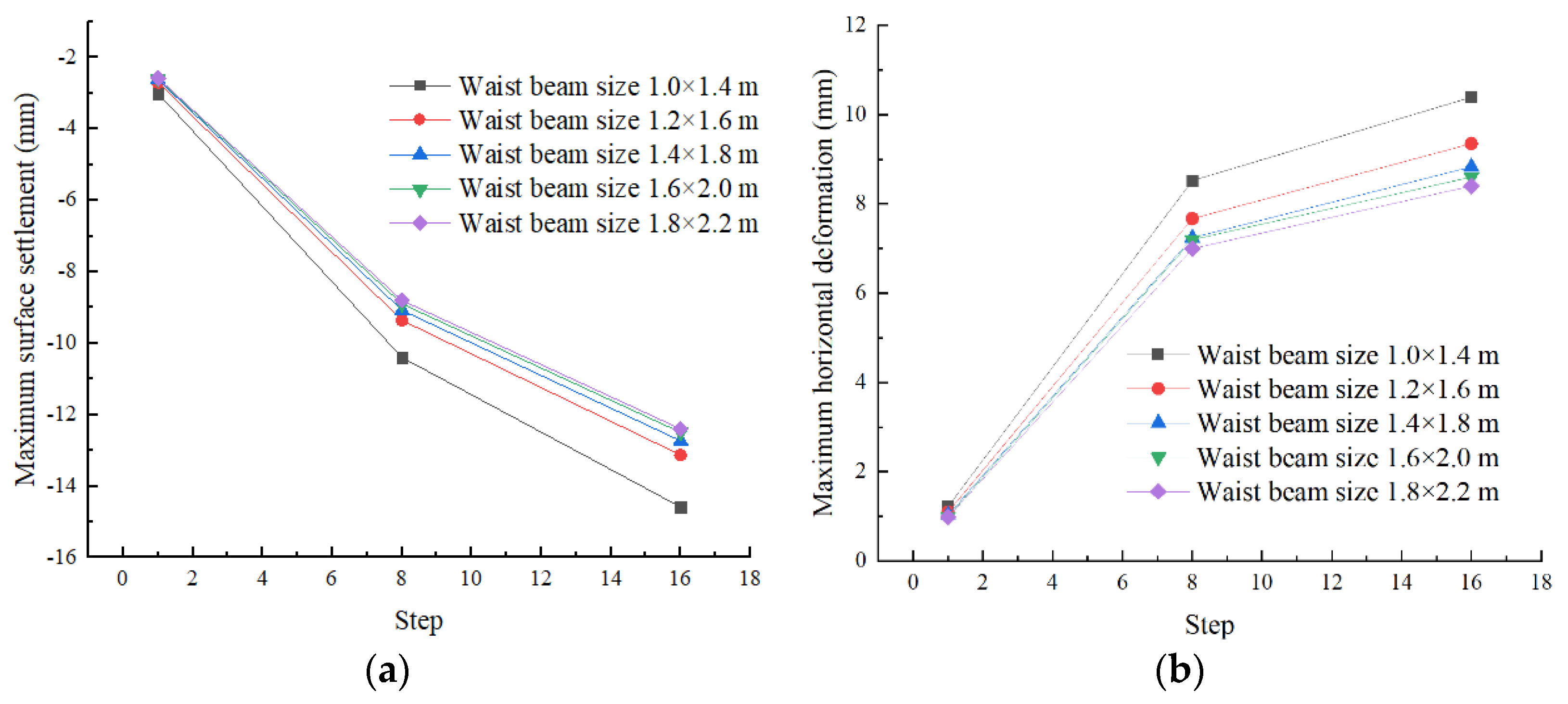
| Serial Number | Angle (°) | Length (m) | Preload Force (kN) | Diameter (m) | Anchor Point Depth (m) |
|---|---|---|---|---|---|
| 1 | 8 | 55.5 | 450 | 0.15 | −3.0 |
| 2 | 8 | 63.5 | 450 | 0.15 | −5.0 |
| 3 | 8 | 56 | 450 | 0.172 | −7.0 |
| 4 | 8 | 22 | 450 | 0.15 | −9.0 |
| 5 | 15 | 29.5 | 650 | 0.172 | −11.0 |
| 6 | 15 | 26 | 650 | 0.172 | −13.0 |
| 7 | 15 | 23 | 650 | 0.172 | −15.0 |
| 8 | 15 | 22 | 650 | 0.15 | −17.0 |
| 9 | 15 | 20 | 650 | 0.15 | −20.0 |
| 10 | 15 | 20 | 650 | 0.15 | −23.0 |
| 11 | 15 | 20 | 650 | 0.15 | −26.0 |
| 12 | 15 | 20 | 650 | 0.15 | −29.0 |
| Natural Gravity γ (KN/m3) | Cohesion c (kPa) | Friction Angle φ (°) | Elastic Modulus (MPa) | Poisson’s Ratio | |
|---|---|---|---|---|---|
| Plain fill | 19.5 | 12 | 8 | 8 | 0.3 |
| Mucky soil | 18.2 | 12 | 6 | 4 | 0.35 |
| Silty clay | 19.5 | 30 | 18 | 16 | 0.25 |
| Coarse sand | 20.2 | 0 | 35 | 40 | 0.25 |
| Round gravel | 20.5 | 0 | 40 | 60 | 0.25 |
| Strongly weathered argillaceous siltstone | 21.9 | 40 | 40 | 82 | 0.25 |
| Moderately weathered argillaceous siltstone | 22.9 | 48 | 48 | 460 | 0.25 |
| Material | Elastic Modulus (MPa) | Natural Heavy γ (KN/m3) | Poisson’s Ratio | Size (m) | |
|---|---|---|---|---|---|
| Waist beam | Concrete | 35 | 23.5 | 0.28 | 1.0 × 1.4 |
| Ribbed beam | Concrete | 35 | 23.5 | 0.28 | 0.4 × 0.4 |
| Crown beam | Concrete | 35 | 23.5 | 0.28 | 1.0 × 1.4 |
| Cast-in-place pile | Concrete | 35 | 23.5 | 0.28 | Diameter 1.4 |
| Anchor cable | Cable | 200 × 103 | - | 0.20 | Diameter 0.15 or 0.172 |
Disclaimer/Publisher’s Note: The statements, opinions and data contained in all publications are solely those of the individual author(s) and contributor(s) and not of MDPI and/or the editor(s). MDPI and/or the editor(s) disclaim responsibility for any injury to people or property resulting from any ideas, methods, instructions or products referred to in the content. |
© 2023 by the authors. Licensee MDPI, Basel, Switzerland. This article is an open access article distributed under the terms and conditions of the Creative Commons Attribution (CC BY) license (https://creativecommons.org/licenses/by/4.0/).
Share and Cite
Yin, Q.; Fu, H.-L. Analysis of Foundation Pit Excavation Deformation and Parameter Influence of Pile-Anchor-Ribbed-Beam Support System. Appl. Sci. 2023, 13, 2379. https://doi.org/10.3390/app13042379
Yin Q, Fu H-L. Analysis of Foundation Pit Excavation Deformation and Parameter Influence of Pile-Anchor-Ribbed-Beam Support System. Applied Sciences. 2023; 13(4):2379. https://doi.org/10.3390/app13042379
Chicago/Turabian StyleYin, Quan, and He-Lin Fu. 2023. "Analysis of Foundation Pit Excavation Deformation and Parameter Influence of Pile-Anchor-Ribbed-Beam Support System" Applied Sciences 13, no. 4: 2379. https://doi.org/10.3390/app13042379
APA StyleYin, Q., & Fu, H.-L. (2023). Analysis of Foundation Pit Excavation Deformation and Parameter Influence of Pile-Anchor-Ribbed-Beam Support System. Applied Sciences, 13(4), 2379. https://doi.org/10.3390/app13042379





